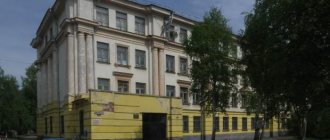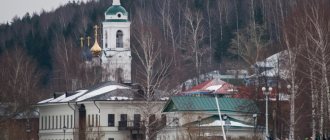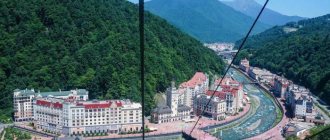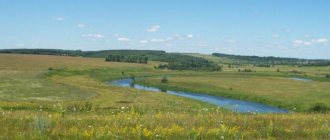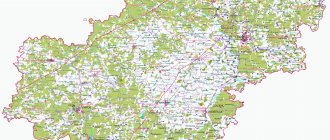The Altai region is famous for its unique nature and favorable climate. With a satellite map of the Altai Territory, it can be found on the territory of Western Siberia.
The map is a reliable companion on any journey; with its help you can find out exact distances. This area stretches from east to west over a distance of more than 600 km. The map will help you find a convenient path to the desired object.
The routes of the Altai Territory on the map show that from Moscow to this region there are just under three thousand kilometers. This is if you travel by train. You will have to cover a distance of 3.6 thousand kilometers in your car.
Almost all natural zones of Russia are found in the region. These are taiga, mountains, and vast steppes. There are a huge number of caves in the foothills.
The leading industries of the region are mechanical engineering and agriculture.
Central regions on the map of Altai Krai
When looking for areas on the map of the Altai Territory, it is worth highlighting the following objects:
- In the eastern region of the region is the Biysk district . The terrain is mostly hilly. Gravel and sand are mined on its territory. Numerous rivers flow through the area: Shubenka, Biya, Katun.
- Zarinsky district was not so long ago called Sorokinsky. On its territory, development and extraction of materials for the further creation of cement and brick are underway. Using a map of the Altai Territory, more than 50 settlements in a given area can be identified by region.
- Rubtsovsky is considered one of the central districts . This area has flat terrain and steppe vegetation. Agriculture is one of the most important areas of activity. Also in the region there are motor transport enterprises, and a variety of ores are mined. Important routes to Barnaul and Zmeinogorsk pass through the area.
- In the northeast is the Pervomaisky district . This is one of the most developed and richest areas of the region. On its territory, with a detailed map of the Altai Territory, you can find organizations in the woodworking industry, as well as agricultural farms. The area is crossed by the railway artery and the P 374 m M 52 highway. There are many attractions in the area. It is worth visiting the archaeological sites that belonged to the ancient Scythians.
Using a road map of the Altai Territory will allow you to find all areas of the region and its attractions.
Coronavirus statistics in the Altai Territory as of December 10, 2021
Over the past 24 hours, 520 new cases of coronavirus infection have been registered in the region. The total number of cases of coronavirus infection is 109,253 people, including 9,207 children. 83,836 people have recovered (+ 1,025).
A total of 7,468 people died (+ 27), all adults, including due to causes of death: coronavirus infection - 6,029 people (+ 27), other causes of death - 1,439 people (+ 0).
As of December 10, 2,929 people are being treated in infectious diseases hospitals with laboratory-confirmed coronavirus infection. In addition, 266 patients with radiologically confirmed viral pneumonia similar to COVID-19 are being treated in Covid hospitals. The number of seriously ill patients is 634, of which 248 are connected to ventilators. The Ministry of Health of the region has deployed 4201 beds, 3304 are connected to oxygen, and 360 with mechanical ventilation. Reserve beds: 4201-2929-266=1006.
62 people (asymptomatic virus carriers) are under outpatient observation and treatment. 291 patients with radiologically confirmed viral pneumonia similar to COVID-19 are undergoing outpatient follow-up treatment in a hospital setting at home.
Of the total number of cases, 942 cases are imported, incl. 248 – from abroad; 69,875 cases were due to contact with previously ill persons. Of the 109,253 cases: 22,335 were patients with community-acquired pneumonia, 77,160 were cases of acute respiratory viral infection, 9,758 cases were asymptomatic.
In total, 2,693,480 people were examined for the new coronavirus infection in the region. The average daily testing coverage of residents of the region was 359.79 tests for every 100 thousand residents or 8890 people per day. The number of tests taking into account repeated studies is 9168 over the past day.
The Altai Territory received 1,388,088 sets of vaccine against the new coronavirus infection COVID-19 for medical organizations.
As of the morning of December 10, 2021, 1,087,581 people were vaccinated against COVID-19 in the Altai Territory, including: 111,423 people received the first vaccination; 925,340 people are fully vaccinated (received two shots or one shot of Sputnik Light); 50,808 people have received RE-VACCINATION.
Diversity of cities and villages of the Altai Territory on the map
The Altai region is full of many interesting cities. The most famous include the following:
- It is believed that the city of Barnaul was founded by the miner Demidov in the 18th century. After the war, the city gained fame as an industrial center. Manufacturing enterprises, as well as retail and wholesale trade, are actively developing in the city. Famous attractions that the map of the Altai Territory displays in detail include Lenin Avenue with beautiful chapels and openwork lanterns, as well as a building with a spire and a bridge spanning the Ob.
- Biysk is considered a city that opens the gates to the mountainous part of Altai. Many tourist routes start from here. This city has a local history museum, more than 260 architectural, natural and archaeological monuments.
- Zarinsk grew out of the village of Sorokino, which appeared in the 18th century. The city is geographically located on the coast of the Chumysh River. This is clearly demonstrated by the map of the Altai Territory. Altai is considered an important enterprise of the entire settlement - coke. Also in the city there is a multidisciplinary construction company, a butter and cheese plant and an elevator.
- Rubtsovsk is considered one of the main cities. Manufacturing enterprises are easy to find with a map of the Altai Territory with cities in good quality.
- Novoaltaysk is considered the center of the Pervomaisky district. It is located on the banks of the adjacent river, the Ob. The city has a large railway junction. This is a city with developed industry. It has a large machine-building enterprise, a reinforced concrete products plant, as well as numerous catering and trade enterprises.
General information about the Altai Territory
The land of a thousand lakes, the land of caves and springs.
A place where endless steppe expanses mix with thickets of forests, turn into the blue of mountain peaks and dissolve behind the smoky horizon in the huge sky. Being the heart of the Eurasian continent, the Altai region is rightly named by UNESCO as one of the best places on Earth for recreation and living. A place with an abundance of natural zones in Russia, glorified by Vasily Shukshin in his work, sacred Siberian Shambhala. In addition to mechanical engineering, which is the leading industry in the region, agriculture is widely developed, and the Altai Territory ranks first in the production of environmentally friendly products in Russia. The favorable climate, natural healing resources and the dazzling beauty of the Siberian pearl led to the development of the tourism industry, sports and entertainment recreation and medical and health institutions.
Unfortunately, at the moment the unique ecology of the Altai Territory is rapidly deteriorating. This is mainly due to the heavy and chemical industries that form the basis of the region's economy, as well as the use of a nuclear testing site near Semipalatinsk. At the same time, it is planned to create numerous reserves, wildlife sanctuaries, national parks, and natural monuments.
Emerald forests of Altai
Geographical location
The Altai Territory borders in the northern part with the Kemerovo region, as well as the Novosibirsk region, with which it is connected by the blue thread of the Ob River. In the southeast - with the Altai Republic, and in the south and west with Kazakhstan, from which it often receives gifts from Baikonur in the form of fragments of rocket stages and the remains of rocket fuel in the air. Plains and mountains...in general, the entire Altai region resembles a hill that increases from northwest to southeast.
There are many caves on the mountain slopes; in some, scientists even find traces of the existence of ancient man. Of the 11,000 lakes in the region, the slightly saline Kulundinskoye Lake (600 km2) is considered the largest. Locals even call it the Altai Sea. It is famous for its mineral waters, healing mud, unique pine shores and sandy beaches. Forest areas are also quite common, among which there are fantastically beautiful ribbon forests.
Kulunda Lake
Climate
Since the Altai Territory is located in the very center of the Eurasian continent, all the oceans are thousands of kilometers away. This means that summer here is most often hot, and temperatures can reach almost Egyptian 40-42 degrees. And in winter there is fairly stable clear weather with severe Siberian frosts, and the temperature can easily drop to −55 degrees Celsius.
The greatest amount of precipitation, 800-900 mm, falls in mountain and steppe areas with ribbon forests. Summer rains and thunderstorms often give way to sunny and clear weather. The number of sunny days in summer is very high, and in this regard, many regions of the Altai Territory can be compared with the best resorts of the North Caucasus and Southern Crimea.
Sunny Valley of the Altai Territory
Population
The population of the Altai Territory is 2,398,750 people, most of whom (55.49%), as one would expect, live in cities. Thanks to the vast Siberian expanses, the population density is only 14.28 people/km2. For comparison, the population density in the Leningrad region is 20.87 people/km2, and in the Moscow region it is as much as 158.82 people/km2.
Despite the fact that the birth rate began to increase since 2007, unfortunately, at the moment the population growth rate remains negative. Most likely this is due to the desire of people to live in cities with over a million people, where opportunities for career and growth are much higher. Most of the population (86.79%) are Russians.
Unemployment and average wages
Over the past 8 years, the unemployment rate in the Altai Territory has reached a minimum of 2.4%, and is one of the lowest in the Siberian Federal District. More than 70% of people who applied to employment centers managed to find a job. It is also good news that, as part of the implementation of socially significant work, more than 20,000 temporary and permanent jobs were created, including for unemployed disabled people, large families, etc.
Small businesses were also not ignored: many aspiring entrepreneurs were allocated 60,000 rubles each to develop their business. More than 600 graduates of professional institutions were sent for internships for possible further employment.
With all this, the level of salaries in the Altai Territory occupies a completely disgraceful last 12th place in the district. It is difficult to say whether this is due to the general poverty of the region, the absence of black rivers or nickel mountains, but the fact remains: the average salary of people is no more than 18,000 rubles. For comparison, the average teacher salary in the Yamalo-Nenets Autonomous Okrug is more than 69,000 rubles per month, but in the Altai Territory teachers receive only 15,000 rubles.
Crime
After the murder of the most famous crime boss in Russia, Aslan Usoyan (Ded Khasan), who controlled up to 70% of all thieves in law in Siberia, many law enforcement agencies rightly feared a significant increase in crimes associated with the redistribution of spheres of influence. However, at the moment the crime rate in the Altai Territory is one of the lowest in the Siberian Federal District, and is second only to the Omsk Region.
Meanwhile, the main problem leading to the commission of crimes, as throughout Russia, is alcohol and drugs. According to statistics, in the Altai Territory in 2012, every third crime was committed by a person while intoxicated.
Real estate
It is quite possible to buy a very good two-room apartment on the secondary real estate market in Barnaul, for example, for 2,000,000 rubles, and renting such an apartment will cost you no more than 25,000 rubles per month. Real estate prices are significantly lower than in Moscow and St. Petersburg. But prices for suburban real estate vary quite significantly. Here, as elsewhere, the price depends on personal fantasies, and most importantly, possibilities: the cost of some buildings can reach 20,000,000 rubles, in no way inferior to the capital’s cottages.
Relief and climate
The Altai Territory on the map of Russia occupies part of the West Siberian Plain, the low-mountain hills of the Salair Ridge and a little of the Altai foothills. Most of the region has a flat landscape, which is characteristic of the western, eastern and central regions of the region. Thanks to the protection of the high ridges of the Altai Republic from the southeast, a variable temperate climate with positive average annual temperatures has been formed in the region.
Summer is characterized by heat of +25-28°C and strong northern winds. In steppe areas, prolonged dry winds may occur. Winters are quite cool -22-18 °C. The absence of a frosty period is about 5 months a year. The first snow falls in early November. The depth of snow cover is uneven across regions. In the west of the region it is 40-50 cm, in the east – 20-25 cm. Massive melting of snow occurs in early to mid-April.
Administrative division
The map of Altai with populated areas displays in detail the location of each city, ZATO and district, of which today there are 12, 1 and 59 respectively (see table).
| No. | City/district | Location on the map of Altai Territory | Population, thousand people | Area, km2 |
| 1 | Aleysk | center | 29,0 | 43,9 |
| 2 | Barnaul | northeast | 640 | 322,0 |
| 3 | Belokurikha resort town | southeast | 15,2 | 92,3 |
| 4 | Biysk | southeast | 692,3 | 291,7 |
| 5 | Gornyak (old name Zolotukha) | southwest | 13,3 | 28,0 |
| 6 | Zarinsk | northeast | 46,7 | 79,2 |
| 7 | Zmeinogorsk | southwest | 10,5 | 35,1 |
| 8 | Kamen-on-Obi | northwest | 40,8 | 48,8 |
| 9 | Novoaltaysk | northeast | 73,4 | 72,2 |
| 10 | Rubtsovsk | southwest | 144,1 | 84,0 |
| 11 | Slavgorod | northwest | 30,0 | 53,3 |
| 12 | Yarovoye (therapeutic mud) | northwest | 18,1 | 44,4 |
| 13 | urban-type settlement Sibirsky (ZATO – closed administrative-territorial entity/missile forces) | northeast | 12,0 | 7,1 |
| 14 | Aleysky district | center | 14,5 | 3400 |
| 15 | Altai district | southeast | 25,9 | 3350 |
| 16 | Baevsky district | northwest | 9,2 | 2700 |
| 17 | Biysk district | southwest | 31,8 | 2200 |
| 18 | Blagoveshchensky district | west | 28,5 | 3650 |
| 19 | Burlinsky district | northwest | 10,4 | 2750 |
| 20 | Bystroistok district | southeast | 8,9 | 1800 |
| 21 | Volchikhinsky district | west | 17,4 | 3600 |
| 22 | Yegoryevsky district | southwest | 13,1 | 2500 |
| 23 | Yeltsovsky district | East | 6,1 | 2150 |
| 24 | Zavyalovsky district | west | 18,0 | 2200 |
| 25 | Zalesovsky district | northeast | 14,0 | 3300 |
| 26 | Zarinsky district | northeast | 17,5 | 5200 |
| 27 | Zmeinogorsk district | south | 19,3 | 2800 |
| 28 | Zonal district | southeast | 20,2 | 1700 |
| 29 | Kalmansky district | center | 12,9 | 1800 |
| 30 | Kamensky district | north | 51,4 | 3600 |
| 31 | Klyuchevsky district | west | 16,5 | 3100 |
| 32 | Kosikhinsky district | northeast | 15,9 | 1900 |
| 33 | Krasnogorsk district | southeast | 15,2 | 3100 |
| 34 | Krasnoshchekovsky district | south | 16,7 | 3550 |
| 35 | Krutikhinsky district | north | 10,8 | 2050 |
| 36 | Kulundinsky district | west | 22,1 | 2000 |
| 37 | Kurinsky district | south | 9,4 | 2500 |
| 38 | Kytmanovsky district | northeast | 12,6 | 2600 |
| 39 | Loktevsky district | south | 26,0 | 2250 |
| 40 | Mamontovsky district | cent | 22,3 | 2300 |
| 41 | Mikhailovsky district | southwest | 19,7 | 3100 |
| 42 | German national district (center in the village of Halbstadt) | northwest | 16,4 | 1450 |
| 43 | Novichikhinsky district | southwest | 9,2 | 3100 |
| 44 | Pavlovsky district | north | 40,7 | 2200 |
| 45 | Pankrushikhinsky district | northwest | 12,1 | 2700 |
| 46 | Pervomaisky district | northeast | 53,8 | 3600 |
| 47 | Petropavlovsky district | southeast | 11,8 | 1600 |
| 48 | Pospelikhinsky district | southwest | 23,2 | 2400 |
| 49 | Rebrikhinsky district | center | 23,0 | 2700 |
| 50 | Rodinsky district | west | 18,8 | 3100 |
| 51 | Romanovsky district | west | 11,9 | 2100 |
| 52 | Rubtsovsky district | southwest | 23,7 | 3300 |
| 53 | Smolensk district | southeast | 22,0 | 2050 |
| 54 | Sovetsky district | southeast | 15,5 | 1500 |
| 55 | Soloneshensky district | southeast | 9,6 | 3500 |
| 56 | Salton district | East | 7,5 | 3000 |
| 57 | Suetsky district | northwest | 4,5 | 1100 |
| 58 | Tabunsky district | west | 9,3 | 2000 |
| 59 | Talmensky district | north | 46,6 | 3900 |
| 60 | Togulsky district | northeast | 7,8 | 2000 |
| 61 | Topchikhinsky district | center | 22,3 | 3300 |
| 62 | Tretyakovsky district | south | 12,7 | 2000 |
| 63 | Troitsky district | northeast | 23,0 | 4200 |
| 64 | Tyumentsevsky district | northwest | 14,2 | 2300 |
| 65 | Uglovsky district | southwest | 12,5 | 4800 |
| 66 | Ust-Kalmansky district | south | 14,2 | 2200 |
| 67 | Ust-Pristansky district | center | 11,5 | 2650 |
| 68 | Khabarsky district | northwest | 14,6 | 2750 |
| 69 | Tselinny district | East | 15,3 | 2900 |
| 70 | Charyshsky district | southwest | 11,4 | 6900 |
| 71 | Shelabolikha district | north | 12,8 | 2500 |
| 72 | Shipunovsky district | southwest | 32,3 | 4100 |
As a result of the municipal reform of 2006, the Slavgorod district was abolished, which territorially became part of the municipal formation “city of Slavgorod”.
